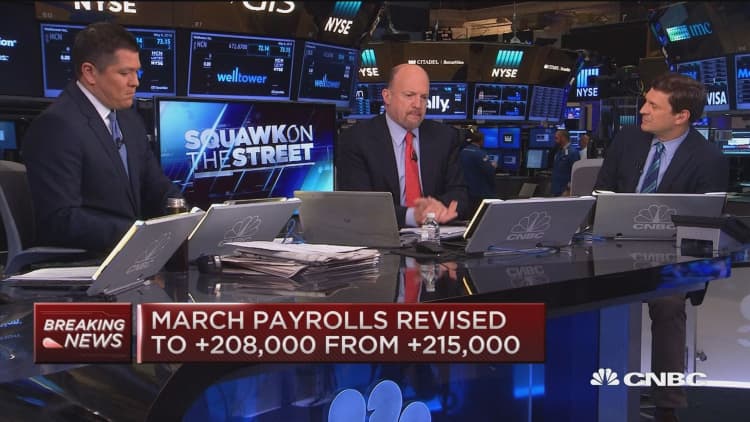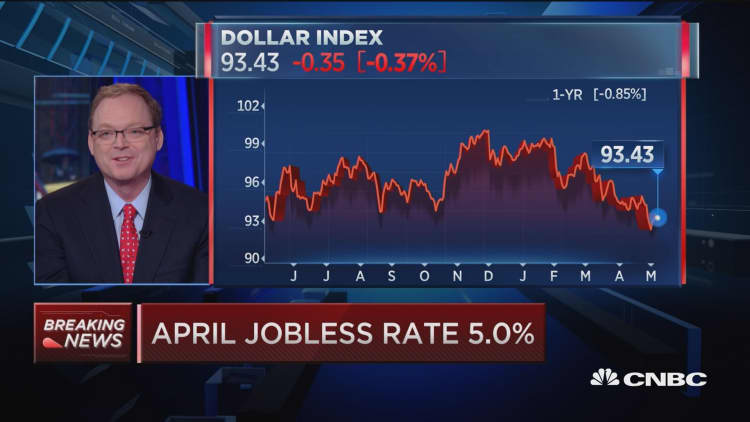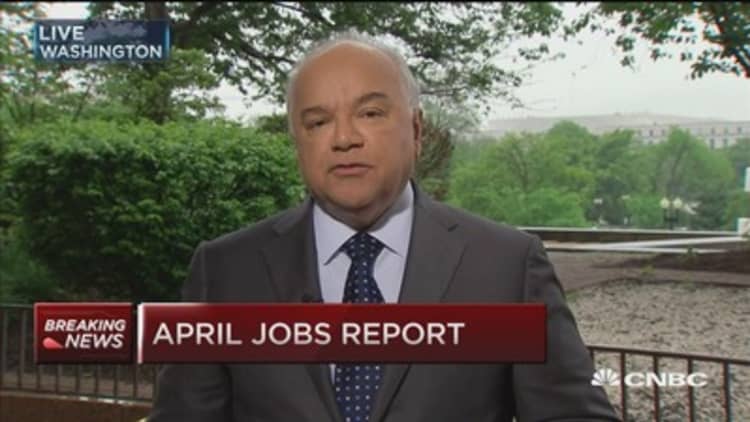



The U.S. economy created just 160,000 jobs in April, lower than economist expectations, while the unemployment rate held steady at 5 percent.
On the bright side, wages rose during the month, with average hourly earnings up 8 cents an hour, representing a 2.5 percent annualized gain. The average work week edged higher to 34.5 hours, according to the Bureau of Labor Statistics, which issues the monthly jobs report.
Those counted as not in the labor force surged by 562,000 for the month to more than 94 million.
Stock futures briefly fell after the report but regained some ground as Wall Street prepared for a lower open. Traders in the fed futures market pulled back expectations even more, estimating only a 50-50 chance that the U.S. central bank would hike rates even once this year.
"The headline number was definitely disappointing, and all but erases any chance of a rate hike in June," said Chris Gaffney, president of world markets at EverBank. "Without any real wage pressure and the uncertainty of a presidential election in the fall I think the (Federal Open Market Committee) will be forced to sit on their hands until the end of the year. This confirms we will have lower rates for longer — more of the same."
A separate measure of unemployment that includes those working part-time for economic reasons as well as discouraged workers — often referred to as the "real" unemployment rate — fell one-tenth of a point to 9.7 percent. The labor force participation rate, which had been on the rise in recent months, fell to 62.8 percent, its lowest level since January. The total labor force contracted by 362,000.
Wall Street had expected the nonfarm payrolls report to show growth of 202,000 and the jobless rate to remain unchanged at 5 percent. Just a day before the report came out, Goldman Sachs said estimates were too low, with the firm projecting that April would show a gain of 240,000.
Capital Economics had been looking for 170,000, and said after the report was released that the previous level of job creation — a 232,000 average over the past 12 months — was "unsustainable in an economy with a potential economic growth rate of less than 2 percent." However, Paul Ashworth, Capital's chief U.S. economist, said "there is nothing here to swing the Fed's June rate decision very far in either direction" and predicted the FOMC still will hike in June, something the market gives virtually no chance of happening.
Job growth was concentrated in the services sector, which added 65,000 positions, higher than its 12-month average of 51,000 per month. Health care was up 44,000, while financial institutions added 20,000 despite some high-profile layoff announcements on wall Street. Mining lost another 7,000.
Gains in general were tilted toward part-time work, with full-time workers declining by 253,000 and part-time workers also dropping, but by just 21,000, according to the household survey.
The report comes at a tenuous time for the U.S. economy, which grew just 0.5 percent in the first quarter is on pace for just a 1.7 percent rise in the second quarter, according to the Atlanta Fed.
Recent indications show little underlying momentum. A report earlier this week from ADP and Moody's Analytics had projected private job creation at just 156,000. Retail sales have been mostly weak, productivity has remained low and concerns remain over the muted pace of wage growth.
As a result, the Fed has been kept on hold as it seeks to normalize interest rates after more than seven years near zero.
Previous months' numbers also were revised lower. The BLS cuts the February count from 245,000 to 233,000, while the March total fell from 215,000 to 208,000.


